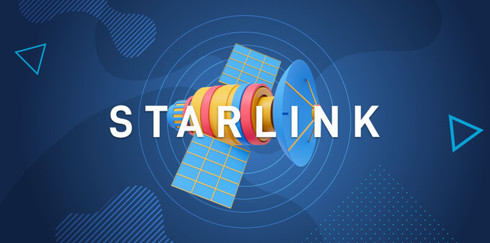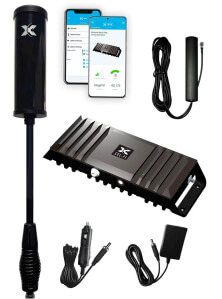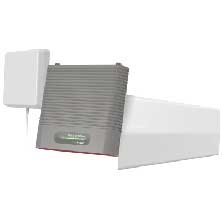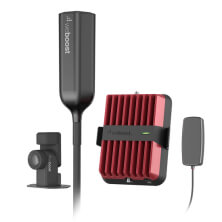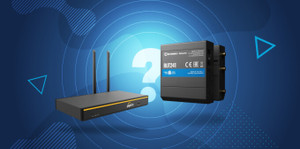What is Starlink Direct to Cell & How Can Cell Boosters Help
How Starlink Direct to Cell and Cell Phone Boosters Will Transform T-Mobile's Connectivity
The T-Mobile and SpaceX “Coverage Above and Beyond” with Starlink announcement in 2022 sparked lots of conversation about the direction of cellular connectivity. Completely eradicating dead zones is a dream scenario, especially for those who live or travel to severely underserved areas.
On January 2, 2024, six Direct to Cellular satellites were launched into orbit, and they work (for texting)! Six days later, Starlink successfully sent and received texts via those satellites using T-Mobile's LTE network.
However, even when satellite-to-cellular evolves to text, voice, and data and is available to all T-Mobile users, cellular connectivity challenges will still exist. Fortunately, cell phone signal boosters can help alleviate those challenges and keep you connected anywhere a sliver of cell signal is available.
Take advantage of our system design and installation services. Learn more or call us for a free consultation: 1-800-969-8189.
What is Starlink?
Starlink operated by SpaceX, is the first and largest satellite constellation using low Earth orbit to deliver broadband internet. It’s ideal for areas with unreliable or nonexistent internet connectivity.
However, Starlink’s focus is not just about broadband anymore. Starlink has entered the satellite to cellular space. Starlink Direct to Cellular aims to provide seamless access to text, voice, and data for LTE phones across the globe.
How Does Starlink Direct to Cellular Work?
Many are familiar with how Starlink satellite internet works. Terrestrial stations broadcast signals to Starlink satellites located about 342 miles above Earth. They then relay the data back to Starlink dish antennas connected to internet routers.
Starlink Direct to Cellular will work in much the same way.
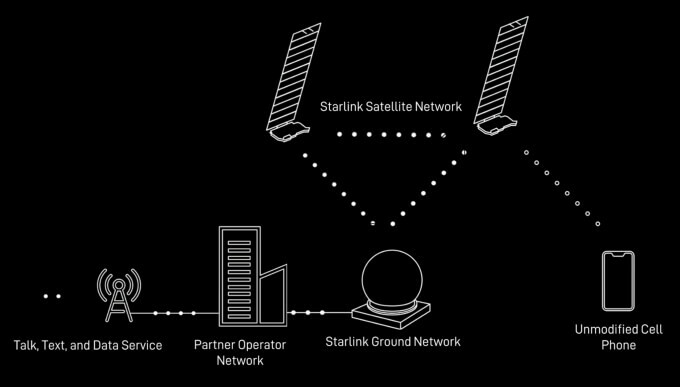
The satellites designed for Starlink Direct to Cellular are different than those for internet connectivity.
SpaceX’s second generation Starlink satellites will be equipped with massive antennas that will emulate T-Mobile cell towers, but from space. To ensure the satellites can detect and transmit a strong signal from space, they are equipped with innovative custom silicone, extremely sensitive radio receivers, high-powered transmitters, and advanced software.
These satellites are designed to use standard LTE/4G protocols. Compared to 5G, LTE/4G signals have a greater range, which is a must for cellular signals coming from satellites located hundreds of kilometers above Earth's surface. Using these protocols also ensures this service works with unmodified cell phones. Elon Musk claims the satellites will transmit direct to mobile phones, eliminating dead zones worldwide.
T-Mobile has allocated part of its mid-band spectrum, specifically Band 2 (1900 MHz), for this service. Once fully implemented, most T-Mobile customers should have coverage almost anywhere without getting new phones or plans.
The satellites will have about 2 Mbps to 4 Mbps of bandwidth to be shared per cell zone, not for each connected device. Due to its limitations, the focus in the early stages will be giving customers text coverage, including SMS, MMS, and participating messaging apps, practically everywhere in the continental US. Starting in 2025, Starlink plans to implement voice and data.
For worldwide coverage, agreements with carriers around the world need to be made. In addition to T-Mobile, SpaceX has signed up six other carriers for this service: Optus (Australia), Rogers (Canada), Entel (Chile), KDDI (Japan), One NZ (New Zealand), and Salt (Switzerland). To provide true worldwide connectivity, Starlink has implemented a roaming strategy with partner countries.
Cellular devices will only connect to Starlink satellites when outside the range of T-Mobile or roaming partner cell towers. Satellite connectivity will be much slower than standard cellular connectivity. Do not expect the same ultra-fast connection.
How to Connect to Starlink Direct to Cellular?
Accessing satellite cellular once available is simpler. All you need is to be subscribed to T-Mobile's network or any of Starlink’s Direct to Cellular partners. There is no need to set up any equipment. Devices will automatically connect to the satellites almost anywhere you have a view of the sky.
What are the Challenges of Starlink Connectivity?
While Starlink has been changing the satellite connectivity game, it still has its disadvantages:
- Network Congestion – In areas with lots of Starlink users, lagging performance is expected during peak hours.
- Reception Loss due to Weather – Satellite signals travel a long way to reach terrestrial devices. Like satellite TV services, rain, snow, and ice can interfere with those signals, causing loss of service. This is especially notable when there is heavy cloud cover.
- Network Outages – If something happens to the Starlink network, many subscribers will lose service for some time.
- Clear View of Sky Requirements – A wide view of the sky is needed to look for and track Starlink satellites as they move across the sky. Tall obstacles, such as trees, buildings, and the like, block or reduce line of vision, lowering performance.
Even though the above issues have been reported in regard to Starlink satellite internet, it’s suspected those same issues will affect satellite cellular. Additional Starlink satellite-to-cell service disadvantages include:
- No Voice or Data Connectivity – As mentioned, the early stages of this service will only support text messages. For voice and data, devices will need to connect to terrestrial cell towers.
- Limited Indoor Coverage – Since satellite cellular signals will not be as strong as cell tower signals, they may be too weak to penetrate building and vehicle materials.
Cell Phone Signal Boosters Make Up for Starlink’s Direct to Cell Deficiencies
Cell phone signal boosters and Starlink satellite cellular are very different from each other and shine in different situations. But together, they can create the ultimate cellular connectivity duo.
How Cell Phone Signal Boosters Differ from Starlink
Cell phone signal boosters are designed to improve your existing cell phone signal, even if weak, for reliable talk, text, and data at home or on the go.
The outside antenna captures the signal, sends it to the amplifier, and your cellular devices receive it even stronger indoors via the inside antenna. However, cell phone boosters can’t keep you connected in total dead zones. They do not create cellular signals.
Starlink’s Direct to Cellular aims to provide coverage in areas untouched by cell signals. They will deliver cell signals to areas where signal boosters wouldn't normally work. Cellular devices will only be able to connect to satellite cellular when outside the range of T-Mobile or roaming partner terrestrial cell towers.
Where Cell Signal Boosters Shine
Even though terrestrial cell towers are very powerful and support voice, text, and data, they have their limitations. Broadcasted signals can only travel so far and are easily disrupted by obstacles, leaving many areas with little to no coverage. In many cases, indoor coverage is less than satisfactory.
In those areas where cell signal is available, even if weak, cell phone signal boosters help keep you connected. Whether in the city or countryside, they amplify your existing cell signal and improve indoor cellular coverage. You won’t have to deal with dropped calls, undelivered texts, or slow data in your house or while driving.
Starlink satellite cellular is meant to keep you connected where terrestrial cell towers don’t reach or can’t be installed. While you won't be able to make calls or access the internet till 2025, you’ll be able to text from current dead zones that have a clear view of the sky, including territorial waters. Though, these signals will not be as strong as the ones provided by terrestrial towers. It’s suspected that they will be too weak to penetrate building materials and other obstacles. That’s where cellular boosters come in!
How Cell Signal Boosters and Starlink Complement Each Other
The biggest challenges T-Mobile users will face with satellite cellular are indoor coverage and obstacles blocking the sky. With available cell signals in underserved areas, cell phone signal boosters can help.
The way they’re designed allows them to capture any existing cellular signal and relay them inside. With the outside antennas having a wide radiation beam, they can capture weak signals even when obstructions are blocking the sky.
Whether you live in a dead zone or are camping in one, your device will receive a connection inside your home or RV. You won’t be limited to only using your mobile devices outside. If the signal booster detects a signal from a distant terrestrial cell tower, you’ll even have voice and data coverage. You would not be restricted to just text.
Who Cell Signal Boosters Are For
Starlink satellites will use T-Mobile's mid-band spectrum. This means only T-Mobile subscribers will be able to benefit from this service. AT&T, Verizon, and other carrier users will not be able to connect to Starlink satellite-to-cellular. Though, AT&T is collaborating with AST SpaceMobile to provide satellite to cellular service.
Cellular boosters, on the other hand, are compatible with all cellular providers. They can boost one carrier or multiple at the same time. If you struggle with poor cell service but don’t want to switch to T-Mobile, you should consider a cell phone signal booster.
Cel-Fi GO M RV
The Cel-Fi GO M RV is a powerful, single-carrier mobile RV cell phone booster. Because it only works with one carrier at a time, it features the highest gain of any mobile cellular booster, up to +65 dB. Through the Cel-Fi WAVE app, you can modify which carrier you want to boost at any given time. You can also switch the GO M RV from mobile mode to stationary mode. When stationary, it offers up to +100 dB gain. While driving on remote roads or camping on the edge of the network, the GO M RV provides superior reception.
weBoost Destination RV
The weBoost Destination RV is the most powerful multi-carrier cell phone booster for stationary motorhomes and towables. It features up to +65 dB gain, with up to +21 dBm uplink and +12 dBm downlink. Its high gain and output powers allow for superior cellular signal boost anywhere for multiple devices. Since it’s equipped with an outdoor Yagi and indoor panel, it works wonders in weak signal areas.
If trying to improve your Starlink Direct to Cellular connection, it may be better to use an omnidirectional antenna. The yagi antenna is designed to point at the signal source. With satellites moving at 7.7 km/s, challenges may occur.
weBoost Drive Reach Overland
The weBoost Drive Reach Overland allows you to camp, travel, and explore the backcountry without a worry. Boasting up to 50 dB gain and up to 26.9 dBm uplink, it does a great job at keeping you connected relatively anywhere adventure takes you. While not as powerful as the Cel-Fi GO M, this can boost signals for multiple carriers at the same time. Featuring an adjustable antenna mount, it offers installation flexibility for overland and off-road vehicles.
Futureproof Your Cellular Connection Today!
Poor cellular service exists in many areas. It will be a few years till Starlink satellite-to-cellular services become a reality for all. Don’t wait to improve your connection at home, in the office, or on the road. Cell phone signal boosters will minimize dropped calls, undelivered texts, and slow data where you live, work, or play, now and in the future.
Signal Boosters is a leading provider of home, office, and vehicle cell phone signal boosters. We also specialize in WiFi solutions. Give us a call at 1-800-470-6777 or email us at info@signalboosters.com with any questions you may have.
Interested in Learning More? Check Out Our Cellular Info Hub / WiFi Info Hub

